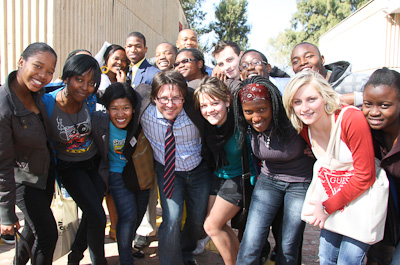 |
Mr Rudi Buys (middle, with tie) with some of the students selected for the F1 Programme
Photo: Gerhard Louw |
The University of the Free State (UFS) has announced the names of the first ever group of 70 first-year students that will travel to the United States of America (USA) as part of the university’s Student Leadership Development Programme.
This group of students will spend two weeks at universities in the USA to experience student life and learn about leadership and diversity at these universities.
“This is a first for not only the UFS, but also for South Africa and we are incredibly proud. The programme is unique to any other student leadership development programme in the country. We are leading the way and are taking students to live and learn amongst students at various universities across the USA,” said Mr Rudi Buys, Dean of Student Affairs at the UFS.
The programme was one of the goals of Prof. Jonathan Jansen, Rector and Vice-Chancellor of the UFS, which he aimed to realise when he was appointed by the UFS in 2009.
“With the programme we want to develop participants’ thinking and capacity to lead in the contexts of diversity and change and we hope to direct them to programmes leading change in student life in general upon their return,” Mr Buys said.
The 70 students will leave for the USA on 22 September 2010. After spending some time there and learning more about their American peers’ lives and culture, they will return to the UFS on 7 October 2010.
“We took great care in selecting the 70 participants. They are representative of all our students, as well as students from our Qwaqwa Campus,” said Mr Buys.
A rigorous selection process was followed, which focused on the students’ academic excellence, their participation in student- and residence-life programmes and their interest in growing in the areas of, amongst others, leadership, diversity and citizenship. Each candidate had to undergo a pre-selection process, followed by a panel interview consisting of staff from various faculties and divisions at the UFS.
The students will stay in groups of about ten at the various universities, which include universities such as Cornell University, New York University, the University of Massachusetts, the Appalachian State University and Virginia Polytechnic University. “These universities will provide our students with accommodation and will present various academic and cultural programmes which our students will participate in and learn from,” said Mr Buys.
“We have also put a programme in place to prepare our students thoroughly for the trip. Because some of them have never travelled on an aeroplane, let alone travelled to a foreign country, we have made arrangements with the Department of Home Affairs for assistance with travel documentation, as well as special arrangements with the USA Embassy for assistance with visas. They will also be attending workshops focusing on, amongst others, research, leadership and diversity before their departure on 22 September 2010.
“Upon their arrival in the USA the group of students will firstly be taken to Washington DC where they will be briefed about American customs, etc. From there they will be placed at the various universities,” said Mr Buys.
Upon their return the students must be involved in student-life programmes on campus, establish volunteer programmes and initiate and establish mentoring programmes for their fellow students. “We want them to give back what they have learnt and experienced,” said Mr Buys.
“We are planning on implementing the Student Leadership Development Programme as an annual programme and are looking forward to this incredible programme through which this group of first-year students will have the opportunity of a lifetime to be true ambassadors of South Africa and, in particular, the UFS, as they leave for the USA,” he said.
Media Release:
Mangaliso Radebe
Assistant Director: Media Liaison
Tel: 051 401 2828
Cell: 078 460 3320
E-mail: radebemt@ufs.ac.za
20 August 2010